
Physics Paper 3 (232/3)
Question 1 . This question consists of two parts A and B; attempt both parts.
PART A
You are provided with the following:
– a pendulum bob
– a stop-watch
– two metre rules
– two retort stands, two bosses and two clamps.
– some thread.
Proceed as follows:
(a) Clamp one metre rule horizontally on the two stands so that the graduations are in a vertical plane. Suspend the pendulum bob from the metre rule with two pieces of thread so that the length of each thread from the point of support on the metre rule to the pendulum bob is 50 cm. See figure 1. The length of each thread will remain 50 cm throughout the experiment. The height of the metre rule above the bench should be at least 65 cm.
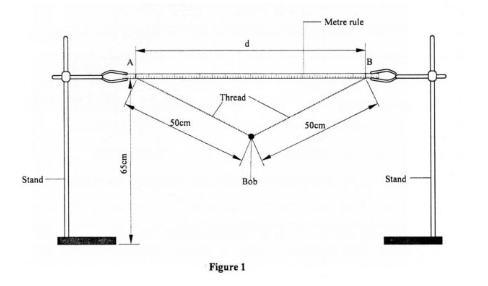
(4 marks)
(d) (i) Plot a graph of T4 (y – axis) against d2. (4 marks)
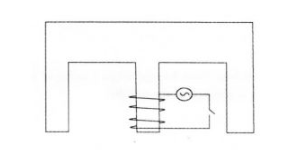
in a plane perpendicular to the length of the metre rule and release it so that it oscillates (c) Repeat the procedure in (b) for other values of d shown in table 1. Complete the table.
Table 1
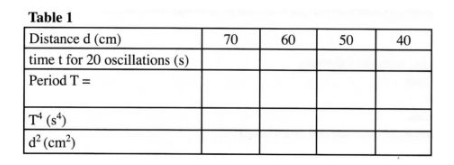
(ii) Determine the slopes S of the graph. (2 marks)
, determine the value of K. (2 marks)
PART B
You are provided with the following:
– one meter rule
– a piece of thread
– stop watch
Proceed as follows.
(e) Using the meter rule measure the length L and breadth b for the magnet.
L = ………………………………
b = ……………………………… (1 mark)
(f) Use the balance to measure the mass M of the magnet.
M = ……………………………. kg. (1 mark)
(h) Clamp the meter rule between the two resort stands. Using a piece of thread suspend in a horizontal plane as shown in figure 2.
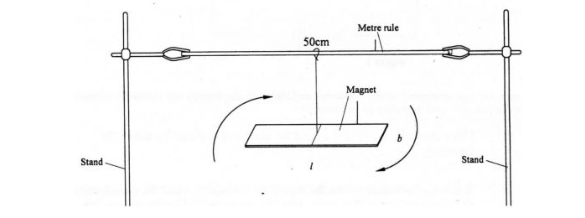
Keep away all unnecessary magnetic materials including voltmeter form this a vertical axis through its centre as shown by the arrows. Measure the time t for
(a) t = …………………………..
(II) Determine the period T of the oscillations. (1 mark)
G
Question 2
This question consists of two parts A and B, attempt both parts.
PART A
You are provided with the following
– a voltmeter
– a capacitor
– a switch
– a stop watch
– five connecting wires
– two cells and a cell holder
Proceed as follows:
(a) Connect the circuit as shown in figure 3.
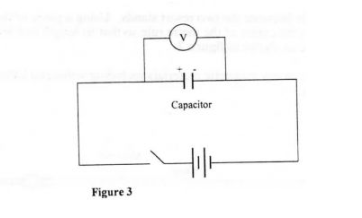
Make sure that the terminals of the capacitor and those of the battery are correctly connected, capacitor.
the stop watch simultaneously. Stop the stopwatch when the voltage has (d) Reset the stopwatch and close the switch. Repeat the procedure in (c) to of the other values shown in table 2.
Table 2
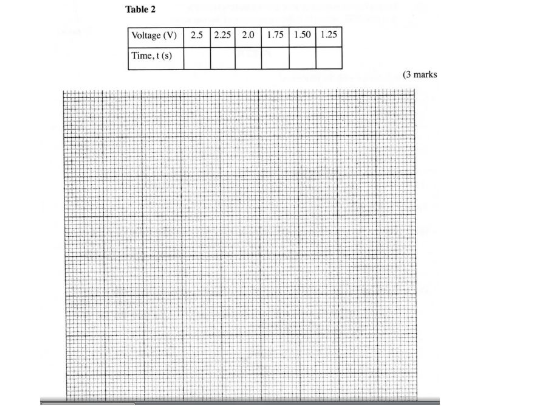
(e) (i) On the grid provided, plot a graph of Voltage V (y-axis) against time t,
(4 marks)
t =…………………. seconds (1 mark) (1 mark)
PART B
You are provided with the following:
– a triangular glass prism
– a metre rule
– a 50 g mass
– some hot water
– some cold water
– some thread
– a thermometer,p> – one stand, one boss and one clamp
– a beaker
Proceed as follows:
(g) Using a piece of thread suspend the metre rule from the clamp on the stand and adjust the position of the thread until the metre rule balances horizontally. Note this position, O of the thread. (This position of the thread must be maintained throughout the experiment).
(h) Using another piece of thread suspend the glass prism from the meter rule at a point 35 cm from O. Suspend the 50 g mass on the opposite side of O using another piece of thread. Adjust the position of the thread attached to the 50 g mass until the metre rule balances once more. See figure 4.
mass. l1 = …………………… cm (1 mark)
(Take g = 10 N kg-1) (1 mark)
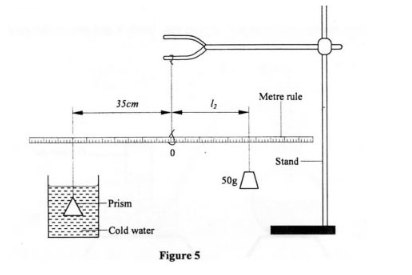
(i) Put cold water into the beaker (approximately three quarter ( 3 4 full). With the glass balances when the prism is fully submerged in the cold water. See figure 5.

(I) l2 = …………………….. cm (1 mark)
(II) Determine the weight W2 of the prism in the cold water. (1 mark)
(j) Measure and record the temperature T1 of the cold water when the system is balanced. T1 = …………………….. oC (1 mark)
(k) Now pour out the cold water and replace it with hot water. Balance the metre rule at 35 cm from 0. is submerged in hot water.
l3 = …………………. cm. (1 mark)
(ii) Measure and record the temperature T2 of the hot water.
T2 =……………………. oC (1 mark)
(iii) Determine the weight W3 of the prism in hot water. (1 mark)
(l) Determine the constant k for the water given that:
k = (w1 – w2) – (w1 – w3)
(w1 – w3) ( T2 – T1)
(2 marks)
